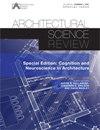Influence of winter natural ventilation on thermal environment of university dormitories under central heating mode in severe cold regions of China
IF 1.8
3区 艺术学
0 ARCHITECTURE
引用次数: 2
Abstract
The indoor thermal environment impacts people’s health, while it can be adjusted by natural ventilation. However, studies on the effects of winter natural ventilation on the thermal environment in severe cold regions are minimal. Through field measurements in university dormitories in winter in Shenyang, China, this study explored, under the central heating mode, the thermal environment differences in different orientations of the dormitory and its different indoor positions under natural ventilation and the influence of window opening area and duration on the thermal environment. The results show that under winter natural ventilation, the air temperature, mean radiation temperature, and adaptive predicted mean vote (APMV) of dormitories facing different orientations were mainly affected by the direct solar radiation reception. When the ventilation duration reached 15mins, with the ratio of window opening area to a ground area of 0.05, 0.11, and 0.16, the APMV decreased by about 0.35, 0.5, and 1, respectively.中国严寒地区集中供暖模式下冬季自然通风对大学宿舍热环境的影响
室内热环境影响人体健康,可通过自然通风进行调节。然而,关于冬季自然通风对严寒地区热环境影响的研究很少。本研究通过对中国沈阳地区冬季高校宿舍的实地测量,探讨了集中供暖方式下,宿舍不同朝向和不同室内位置在自然通风条件下的热环境差异,以及开窗面积和开窗时间对热环境的影响。结果表明:冬季自然通风条件下,不同朝向宿舍的空气温度、平均辐射温度和自适应预测平均投票值(APMV)主要受太阳直接辐射接收的影响;当通风时间达到15min时,开窗面积与地面面积之比分别为0.05、0.11和0.16,APMV分别下降约0.35、0.5和1。
本文章由计算机程序翻译,如有差异,请以英文原文为准。
求助全文
约1分钟内获得全文
求助全文
来源期刊

Architectural Science Review
ARCHITECTURE-
CiteScore
4.80
自引率
8.70%
发文量
34
期刊介绍:
Founded at the University of Sydney in 1958 by Professor Henry Cowan to promote continued professional development, Architectural Science Review presents a balanced collection of papers on a wide range of topics. From its first issue over 50 years ago the journal documents the profession’s interest in environmental issues, covering topics such as thermal comfort, lighting, and sustainable architecture, contributing to this extensive field of knowledge by seeking papers from a broad geographical area. The journal is supported by an international editorial advisory board of the leading international academics and its reputation has increased globally with individual and institutional subscribers and contributors from around the world. As a result, Architectural Science Review continues to be recognised as not only one of the first, but the leading journal devoted to architectural science, technology and the built environment. Architectural Science Review publishes original research papers, shorter research notes, and abstracts of PhD dissertations and theses in all areas of architectural science including: -building science and technology -environmental sustainability -structures and materials -audio and acoustics -illumination -thermal systems -building physics -building services -building climatology -building economics -ergonomics -history and theory of architectural science -the social sciences of architecture
 求助内容:
求助内容: 应助结果提醒方式:
应助结果提醒方式:


